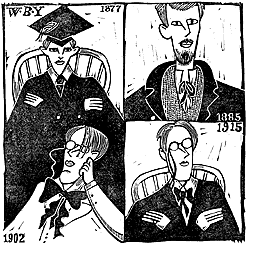
image taken from All Ireland's Bard |
|

image taken from All Ireland's Bard |
|
![]()
I. Contradictions, and self-dislocation, in Yeats' aristocratic Romanticism (his "cultural nationalism"): He identifies himself with "The idealised cavalier, ceremonious lineage of the Anglo-Irish Ascendancy." <--> but he is by birth a protestant bourgeois. <--> also, he rejects the nationalist movement of his time: the Land League. --> doubly dislocated with Irish society. 2. embodiments of this contradiction:
"I have met them at close of day Coming with vivid faces From counter or desk among grey Eighteen-century houses. I have passed with a nod of the head Or polite meaningless words, . . . Being certain that they and I But lived where motley is worn: All changed, changed utterly: A terrible beauty is born." (different from Yeats' views on Irish nationalism in the poems "September 1913": WHAT need you, being come to sense, But fumble in a greasy till And add the halfpence to the pence And prayer to shivering prayer, until You have dried the marrow from the bone; For men were born to pray and save: Romantic Ireland's dead and gone, It's with O'Leary in the grave." 4. similar to Blake and Milton in attempting to construct "cosmic" symbologies, which, in mythologising bourgeois revolution, can assess its historical limitations from the visionary vantage-point of an absolute idealism. e.g. "The Second Coming"; "Leda and the Swan" 5. historical consequence: his support of fascism
note: Ascendancy: 1. a secret society founded in Northern Ireland in 1795 to maintain the political and religious ascendancy of Protestantism. 2. A Protestant Irishman. (The American Heritage) |
"The Second Coming " (the text and illustrations; from Fu Jen English Literature databank)
"Second Coming" [Reading Guide]
General website
on Yeats and Irish Culture:
EssaysWilliam Butler Yeats Page : Good page with lots of links for more information. Harps and Pepperpots. Irish Sites and links focused on mythology, literature, and poetry Nathan Rose's Yeats Web Page. This site offers some Yeats links, "The Visible Yeats" project with scanned images of places and objects mentioned in Yeats's work and The Audible Yeats.
E-Text:Critically Yeats: "'concentrate[s] more on critical material and useful organizations than on text files of Yeats's work.'' W.B. Yeats Society of NY: a site with many Yeats-related links
Collected Poems of W.B. Yeats Bartleby
A brief biography